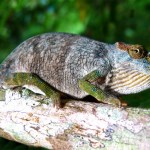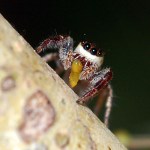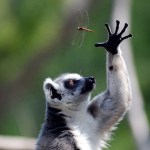
Surely, you've heard about the Census of Marine Life, a 10 year long effort to "assess and explain the diversity, distribution, and abundance of marine life." You may have wondered why it took until 2000 to launch such a project, or why you didn't think to do it first.
This epic venture (which we've posted about here and here) is quickly coming to a close... snorkles are being given one last clean-out blow, goggles are getting a final spit rub, and wetsuits are being signed with "be-cool-stay-in-fish-schools." To mark the occasion, COML provided an end of the year press release last week,…
Dave Goldenberg of Gelf Magazine was kind enough to send along this very graphic, often upsetting, but ultimately pretty awesome video of a baby elephant birth in Indonesia. Watch to the end.
What? Another species?! I thought we were close to being done.
Thanks to Dr. Marshall for the photo
While traipsing through the Magombera forest in east Tanzania, Dr. Andy Marshall spotted a helpless little creature being eaten by a twig snake. With the courage and strength often associated with ecologists, Dr. Marshall rescued a new species of chameleon from the jaws of certain death. Well, actually he and his team startled the snake, causing it to drop the chameleon where Marshall's team then picked it up.
Dr. Marshall and his cohort Michele Menegon named the species Kinyongia…
Feast your eyes on this, squares...
Big up to Ben Thorne for passing this along. And big up to his business, Sneaky's BBQ, the best ribs and pulled pork in the Bay Area. Check them out at www.sneakysbbq.blogspot.com.
New footage of the world's largest stingray.
Thanks to Hunter for bringing this to our attention.
A clip from Werner Herzog's Encounters At The End Of The Earth:
Here's what they look like:
Richard warms up:
Robert Vrijenhoek and Shannon Johnson (Monterey Bay Aquarium Research Institute), and Greg Rouse (Scripps) have recently completed research aimed at classifying 12 new lineages of Osedax worms as their very own species. Upon their 2004 discovery in Monterey Bay, geneticists classified them under the polychaete annelid family Siboglinidae. Since then, approximately 17 distinct lineages have been found, making the "Osedax as full animal kingdom citizens" movement strong.
"Why should I care", you ask.
Say you were a whale from Monterey Bay and your time had come to go on to the great whale…
Sketch by Peter Gulsvig, renowned Zartist
While I believe this bit of news has been well circulated this week, I wanted to give it the Zooillogix bump. Plus, I can only assume Zooillogix readers look to our blog for the latest breaking news... thus it would be a great disservice to all 25 of them to leave this unreported. University of Rochester biologists think they've figured out why the beloved naked mole rat continues to live their entire 30 year moley lifespans without ever having a tumor. That's right. No researcher has ever discovered evidence of cancer in these beauts.
The biologists…
Oral sex is a rarity in the animal kingdom with just a handful of species (humans, bonobos) who participate in the act. Well, move over high-functioning primates because there's a new, high-fellating mammal on the bj circuit, the short-nosed fruit bat. Yeah, we get it, "short-nosed..." We seriously can't make this stuff up.
Random Fact #265: Due to the terms of his Federal plea bargain, Andrew is actually not allowed to watch this video!
Apparently, according to the paper recently published in PLoS ONE, about 70% of female short-nosed fruit bats engage in oral sex with their partners.…
Beautiful and fascinating footage of a Bloodbelly Comb (not a jellyfish, but similarly gelatinous, like my brother) from the Monterey Bay Aquarium's remote operated vehicle. The laser light show comes from tiny transparent, hair-like cilia combined with trace amounts of LSD that will forever remain in your spine.
I could point out that it appears Deep Sea News ran this a few days ago, but we're not talking to them anymore since they went all "academic" on us... I bet they don't even have any shirts with wolves on them.
Straight from Katie and Andrew's closets we bring you this Mountain Dew-soaked photographic essay.
An explosive herbivore bursts forth from your chest
So many, many more below the fold...
Oh my sternum? Yes, it's real bear
Spirit of the Casino
A rare candid glimpse into pre-Columbian North America
We count four offensive things in this shirt. How many can you find?
Seizure inducing dolphins
T-Rexes fight on the moon
Meet Hobbie-J, not your average Long Evans rat:
(photo from Medical College of Georgia)
Behind that unassuming beady eye lurks the smartest rat-brain ever engineered.
You see, Hobbie-J is what scientists Dr. Joe Tsien and Dr. Xiaohua Cao call a "transgenic rat." Her dramatically increased intelligence is the result of genetic tinkering. By over-expressing little Hobbie-J's NR2B gene (a gene partially responsible for learning and memorizing), she was able to remember the solution to mazes and games many times longer than her un-transgenic rat friends. She has also begun frequenting her local…
One of the world's few flightless parrots, the Kakapo is endemic to New Zealand and is notable for having parrot sex with this guy's head.
This is basically Benny's dream date. Thanks to reader Heather H. for sending along.
In a surprise discovery, scientists have discovered the first known mostly vegetarian spider in the jungle mountains of Costa Rica and Mexico. The Bagheera kiplingi was observed feasting not on flies or gnats but on the buds of the acacia plant. Science has known about the Bagheera kiplingi since the late 1800's when naturalists collected dead specimens of them. This is the first time, however, that its behavior was logged.
Um, excuse me. There isn't any gelatin in this plant bud, is there?
Christopher Meehan of University of Arizona in Tucson studied the spiders (while at Villanova),…
I've often pondered how wonderful the world would be if the kitchen and bathroom served the same purpose. It looks like the mountain shrew of Malaysian Borneo has already reached that promised land.
Their diet mainly consists of the nectar that lines the underside of pitcher plant leaves. When dinner is done, the shrew simply takes care of business by defecating into the pitcher part of the pitcher plants. The circle is complete when the plant (normally thought to feed on insects and other carnivorosities) absorbs the nitrogen rich nuggets of love.
Oh, and I forgot one last thing: the…
A ridiculously cool dinosaur encounter on a German TV show. Part animatronics, part puppet show, and part Sprockets. Some great Halloween costume ideas.
If you are unfamiliar with South Korea's Everland Zoo and their ridiculously talented photographer who goes by FloridaPFE on Flickr, time to make a new friend.








